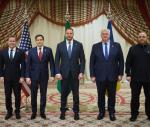This year marks the 100th anniversary of the outbreak of World War I — and, arguably, the worst year in human history. A century later, is the world any safer?
Not only did World War I leave almost 40 million people dead, it can be viewed as a precursor to World War II. After all, had Germany’s hyperinflation of the 1920s — a direct result of the war — been avoided, Hitler may well never have risen to power, and World War II might not have occurred.
Instead, the assassination of Austrian Archduke Franz Ferdinand in Sarajevo on June 28, 1914, set in motion a chain of bloodletting that killed nearly 100 million people by 1945 and caused human suffering on a previously unimaginable scale.
Of course, generations of historians have meticulously researched the origins of the world wars and written elegantly about their conclusions. That history should spur today’s economists and policy makers to reflect on the difficult trade-off between efficiency and robustness when it comes to global governance.
The painstaking effort since the end of World War II to build effective regional and global governance institutions has reduced considerably the risk of catastrophes like the world wars or the Great Depression. Indeed, while such institutions are far from perfect, the progress that has been made in terms of preventing human suffering is worth far more than the efficiency costs of ensuring that they are adequately robust.
This efficiency robustness trade off exists in many fields. When designing an airplane, aeronautical engineers must ensure sufficient robustness so that their creation can avoid crashing even under highly unusual or unforeseen circumstances.
This requires a degree of redundancy — for example, extra engines and extensive backup systems — that comes at the cost of efficiency.
Economic systems also must be robust, as episodes like the Great Depression or the 2008 global financial crisis demonstrate.
In the United States, in particular, the financial sector’s structure prior to the recent crisis emphasised the efficient generation of huge profits — and succeeded for more than a decade. But the realisation in 2007 that some of the system’s fundamental assumptions were no longer valid triggered a crisis with huge economic and social costs.
Had governments worldwide not intervened with massive rescue and stimulus packages, the consequences would have been catastrophic.
That near miss highlighted the unsustainability of pre-crisis policies. The new Basel III banking guidelines, together with new national regulations, aim at creating a more robust financial system by insisting on higher capital-adequacy ratios, less leverage, greater separation between investment and retail banking, a better macro-prudential framework, and measures to prevent financial institutions from becoming “too big to fail”.
All of these efforts are shaped by the efficiency-robustness trade-off. If capital requirements are pushed too high, banks become less profitable, making it more difficult for them to channel savings to investment and undermining economic growth. The challenge, therefore, is to find the ideal balance between opportunity and security — that is, between efficiency and robustness.
Policy makers face a similar challenge when designing, for example, efforts to combat climate change.
The scientific consensus is that greenhouse-gas emissions are generating significant risks, but the scale and timing of these risks remain uncertain.
To illustrate the trade-off (in admittedly simplistic terms), a 14 per cent capital-adequacy ratio for banks may be compared to the objective of stabilising CO2 levels in the atmosphere at 450 parts per million, with both targets reflecting caution and a desire for robustness, at an immediate economic cost.
By contrast, a capital-adequacy target of 7 per cent and a CO2 target of 550 ppm would demonstrate policy makers’ willingness to place a higher priority on short-term gains — even if that means allowing another financial crisis or long-term economic and human consequences of the global warming to manifest themselves.
An extreme course in either direction would be a bad idea. After all, it is impossible to avoid all risk and, at a certain point, the level of inefficiency generated by excessive robustness would create new risks of collapse.
Minimising the risk of a major war, depression or financial breakdown thus requires that policy makers find the optimal balance — and that requires more explicit discussion of the efficiency-robustness trade-off.
As it stands, policies are often presented without any mention of costs in terms of efficiency or robustness — and mere awareness of the trade-off is insufficient for effective decision making. Instead, the trade off must be quantified in approximate and reasonably accessible terms to facilitate productive debate and preempt polarised ideological clashes that have little hope of resolution.
Perhaps the commemoration this year of the disaster unleashed in 1914 will inspire people to think more deeply about how to avoid major risks without having to pay a prohibitively high price in lost efficiency and dynamism to ensure robustness and resilience. Now, as then, the fate of the world hangs in the balance.
The writer, former minister of economic affairs of Turkey and former administrator for the United Nations Development Programme, is vice president of the Brookings Institution. ©Project Syndicate, 2014. www.project-syndicate.org












